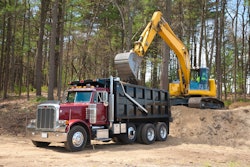
We’ve heard the chatter around the water cooler in a post-pandemic workplace: “No one wants to work anymore." And while that may not be true, currently the construction industry is short roughly 440,000 workers, according to McKinsey. Contractors should expect this vacuum of talent to continue in 2023. To complete jobs this year and beyond, contractors should consider a multipronged solution.
According to the 2023 Engineering and Construction Industry Outlook, labor has been declining due to an aging population and talent pressures in competing industries. During the past 10 years, workers between 25-54 years old decreased by 8%, and older workers left the industry at an increased frequency. Although the construction industry has a strong pipeline of projects, especially infrastructure buildouts, contractors may be challenged to meet demand due to a persistent shortage of workers and high turnover.
More than inflation, supply chain, or governmental policies and regulations, labor shortages will be the defining challenge of the construction economy for the foreseeable future according to a recent economic forecasts. While we may have to weather the immediate climate, construction companies can attract new talent, maximize operators’ productivity and widen their pool of prospective team members through technology adoption. Discover how four technological solutions can solve labor challenges.
1. Attract, Expand Talent Pool With Semi-autonomous Technology.
Since we were all stuck inside during the pandemic – young and old alike are now factoring in commute time and job flexibility when considering a new opportunity. Contractors now can have answers to other “work from anywhere” jobs with semi autonomous technology that can be retrofitted to dozers, trucks, wheel loaders, and more. When installed, operators can control multiple machines while sitting at a comfortable remote-control desk.
Operators can turn on machines wherever they are working and start their day, reducing travel time to remote or tough terrain jobs like mining or quarry sites. Reducing commute times and risk of injury appeals to younger generations according to the 2023 Engineering and Construction Industry Outlook.
Tapping into another machine on another job site quickly can improve productivity and help operators to have a better work-life balance. Even if an operator needs help troubleshooting an issue, dealers at the forefront of the industry’s technology innovation offer remote support to access machine software and solve problems in real-time before calling a field tech or traveling to an equipment store.
Also, adding semi autonomous technology to equipment, like skid steers or compact tractor loaders (CTLs), could open operator positions to those who may not have considered this type of work, including people with physical disabilities.
2. Accelerate Expertise With Machine Control.
With baby boomers leaving the workforce, projects may be delayed as recently hired operators learn the ins and outs of specialty projects. Flattening that learning curve is just one advantage of using new technologies. Yes, you read that right – learning new technology is much faster and intuitive than learning old methods. John Deere and other manufacturers have developed machine control technology to help operators onboard faster while also improving smoothness and accuracy.
Grade management advancements include developing global navigation satellite system (GNSS) receivers to help operators visualize where the machine is relative to the grade, allowing precision grading superior to what used to be considered an acceptable tolerance.
Operators have shared success stories with grade management advancements. In fact, I’ve heard stories of how a new hire can learn how to use the machine in a day and a half as opposed to one week without this technology.
For excavators, accurate horizontal and vertical positioning, where the machine controls boom and bucket movements to a precise design target, can increase production by 30%, allowing the operator to focus on controlling the arm function while the system raises and lowers the boom to maintain grade.
3. Reduce safety risks through surveys and mobile job site mapping.
Each project’s job site is different and changes every day as operators keep equipment working. Operators can benefit from real-time survey and 3D mapping technology to have an accurate view of the site when starting a job.
This type of 3D technology digitally maps a job site with lasers and sends that information back to the equipment, so it can automatically detect potential hazards and/or structures the operators need to build around. Operators who just stepped on the job site benefit from the added automated protection.
In addition, some 3D digital mapping use LIDAR (Light Detection and Ranging) to create high-density, high-precision point clouds, combined with high-resolution panorama survey maps accessed from a phone or tablet. This fusion of GNSS position and inertial measurement technology improves contractors’ ability to keep an eye on the work that’s happening on the job site, even when they are back in the office.
4. Maximize uptime productivity through enhanced communications.
After the COVID-19 pandemic disrupted the industry, contractors have made the shift to see how interconnected machines help their operators maximize productivity and improve communication. Right now, at most job sites, managers and operators are not able to consult with engineers and technology experts in real time. Machine monitoring software with remote support allows operators to communicate what’s happening in the field, and access resources to maximize their uptime.
For example, state-of-the-art technology like Teleo Supervised Autonomy retrofitted to CTLs give any operator the ability to control multiple machines and share data. Enhancing productivity is not only good for the contractor but instills a sense of job satisfaction.
Other technology like Carlson Command Landfill Grade creates triangular communication among the operator, engineer, and technology specialists to monitor grade levels while in the cab, maximizing airspace and extending a landfill’s lifespan.
When equipment is connected to machine health monitoring software like JDLink, remote support teams can predict maintenance needs and troubleshoot in real-time when machines are down. On average, RDO Solutions Center at RDOIC solves issues within 10 minutes, 93% of the time according to General Manager of Technology Support Jay Mercer.
As the market remains uncertain, contractors can offer existing and new employees some peace of mind by adopting technology that enables them to do the work in a flexible and agile way. By offering technology solutions, businesses may be able to widen the pool of talent, especially for hard-to-fill roles.




















